

DJME - The jQuery extensions for ASP.NET MVC - Home. Javascript to IQueryable (by Dynamic Expressions and Queries in LINQ) - Home. Online Book Store - Home. EasyBlog - Home. Books - Home. SheepJax - Home. School Education Management - Home. Garfbradaz/MvcImage. EF4.1 and Asp.net mvc3 Shop Online - Home. ASP.NET MVC 3 Starter Site - Home. ASP.NET MVC Starter - Home. MVC3 Validation Groups - Home. SimpleBlog (ASP .Net MVC3, Entity Framework 4.1, HTML5) - Home.
Task Manager MVC3 - Home. Patterns & practices: Project Silk - Home. PagerHelper for ASP.NET MVC3 - Home. ASP.NET MVC3 Site Template - Home. Sports Store MVC3 - Home. DotNetAge CMS for ASP.NET Mvc3 - Home. POP Forums for ASP.NET MVC 4 - Home. Design and Develop a website using ASP.NET MVC 4, EF, Knockoutjs and Bootstrap - Home. ChrisFulstow/NBlog. Nested Collection Models in MVC to Add Multiple Phone Numbers - Part 1. In this article (multi-part article) you will learn how to create MVC application that will allow adding multiple phone numbers using Nested Model Concept.
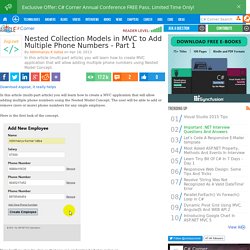
In this article (multi-part article) you will learn how to create a MVC application that will allow adding multiple phone numbers using the Nested Model Concept. The user will be able to add or remove (zero or more) phone numbers for any single employee. Here is the first look of the concept. Now, I will go step-by-step so that you can understand what is going on. First things first. Note, we have navigation properties in both tables and "EmployeeId" in Phone table for each phone number. You will find a property "DeletePhone" in the Phone table, this property will be used as a flag to delete a contact number by the controller method when the user is marked for deletion in the view.
I will share the script file to generate this database at the end of this article. Step 2: Prepopulating Collection (Phone Number input boxes) Aspect Oriented Programming: learn step by step and roll your own implementation! This article started with my need for a good and simple interception mechanism for some requirements that could be solved using AOP techniques.

There are plenty of interceptors out there but most of them (Castle.net, Spring.net, LinFu, etc..) would require to emit dynamic child classes through IL code at runtime and thus ends with almost always the same limitations regarding the classes you can intercept : they can not be static, must be non-sealed, properties and methods must be virtual, etc... Other interceptions mechanism would require to change the build process or to buy a license.
I could not afford one or the other... Table of content AOP stands for Aspect Oriented Programming. I’ll (try to) keep this article at beginner level. Forums application using MVC4 and Entity Framework. Introduction Hi all, in this artcile I would like to show you how we can create a forums application using MVC4 along with Entity Framework.
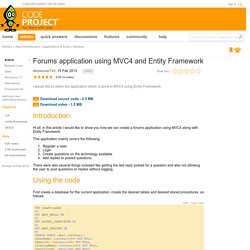
This application mainly covers the following: Register a UserLogin Create questions on the technology available Add replies to posted questions. There were also several things included like getting the last reply posted for a question and also not allowing the user to post questions or replies without logging. Using the code First create a database for the current application, create the desired tables and desired stored procedures, as follows: Hide Copy Code. Anatomy of HTML5/JavaScript Single Page Application in Samples (basics, navigation, composition, communications with the server) Introduction What is Single Page Application (SPA)?
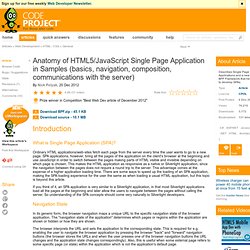
Ordinary HTML applications/web-sites fetch each page from the server every time the user wants to go to a new page. SPA applications, however, bring all the pages of the application on the client's browser at the beginning and use JavaScript in order to switch between the pages making parts of HTML visible and invisible depending on which page is chosen. This makes the HTML application as responsive as a native or Silverlight application, since the navigation between the pages does not require a round trip to the server. This advantage comes at the expense of a higher application loading time.
If you think of it, an SPA application is very similar to a Silverlight application, in that most Silverlight applications load all the pages at the beginning and later allow the users to navigate between the pages without calling the server. Navigation State The browser interprets the URL and sets the application to the corresponding state. How to Build Powerful Search Forms. Introduction Every enterprise application typically has one or several major search forms that are used by multiple types of users.
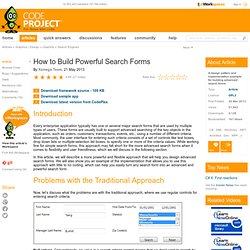
These forms are usually built to support advanced searching of the key objects in the application, such as orders, customers, transactions, events, etc., using a number of different criteria. Most commonly, the user interface for entering such criteria consists of a set of controls like text boxes, drop down lists or multiple-selection list boxes, to specify one or more of the criteria values. While working fine for simple search forms, this approach may fall short for the more advanced search forms when it comes to flexibility and user friendliness, which we will discuss in the following section. Custom Membership Providers. Introduction Authentication is an integral part of every web application.

A number of ways exist to provide authentication support to your websites. But, I personally found that ASP.NET's authentication model is good for this purpose. ASP.NET supports a number of authentication models such as forms, windows, passport, etc. Using one of these methods is surprisingly simple. Part 2 of the article can be found here. Background - Using the Default MembershipProvider Using the default membership provider that comes with ASP.NET is simple and straightfoward.
MVC Techniques with jQuery, JSON, Knockout, and C# Download source code - 4.97 MB Introduction “Change will not come if we wait for some other person, or if we wait for some other time.
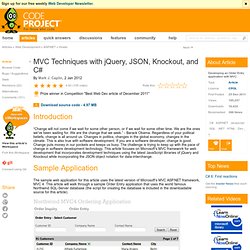
We are the ones we've been waiting for. We are the change that we seek.” - Barack Obama. Regardless of your political beliefs, change is all around us. JSON API. Table of Contents Introduction Hello all, long time since you heard from me, huh?

Well, I have not been dormant, I am actually working on a pretty large Open Source tool for developers; it is kind of an organizational tool which is eating up all my time. In fact, it's not just my time it is eating, it is also eating up a fair chunk of fellow CodeProjecter Pete O'Hanlon's time, who foolishly, um nicely, volunteered to help me out with creating this tool.
The tool is coming along nicely, it is actually an ASP MVC 3 web site, and some of the stuff that I have done in it is pretty useful I think, so I will be creating a few articles about some of the stuff it uses, and I will of course be writing up an article or two about how it works. jTable.org - A JQuery plugin to create AJAX based CRUD tables.
AJAX based CRUD tables using ASP.NET MVC 3 and jTable jQuery plug-in. Contents Introduction to the problem When we are developing a 'data manipulation page', we almost always do the same thing: A 'table/grid' that is used to 'show records' of a table in a database, a 'create new record' page/dialog to add a new record to the database, an 'edit record' page/dialog to edit a record, and finally a way of 'deleting a record' in the database.

Also, using AJAX, we can create more fast and interactive pages. Especially, jQuery and jQueryUI are invaluable libraries to perform manipulation in an HTML page and perform AJAX requests to the server.